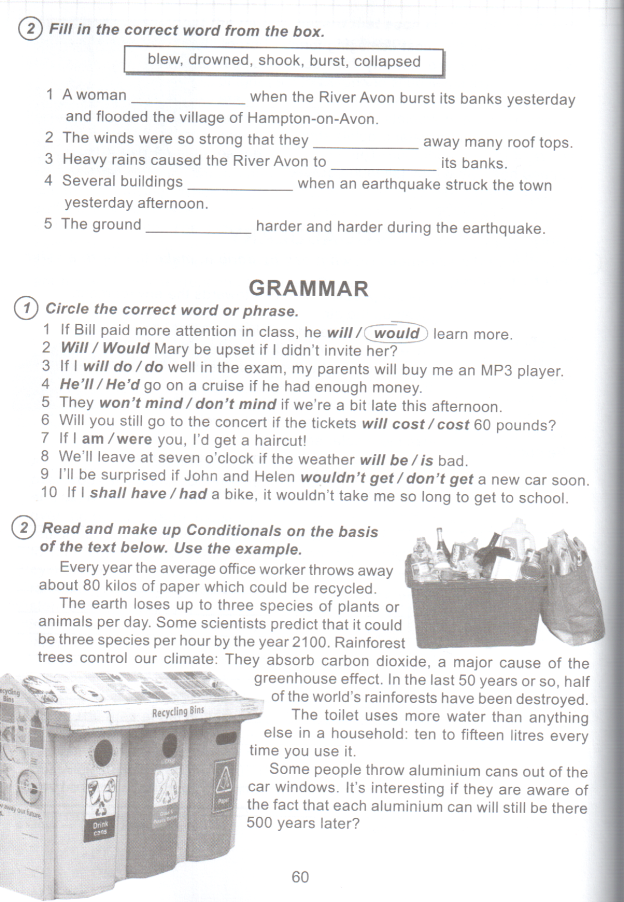Контрольне завдання по темі Is the earth in danger?
|
Date________ Name_________________________ course 1 _____
|
UNIT 6. THE EARTH IN DANGER?
Variant 1
1.Match the parts of the word combinations: make up your own sentences using the word combinations.
1) volcanic
2) heat
3) tropical
4) Spanish
5) earthquake
6) excessive
A) rainfall
B) flu
D) tremors
E) storms
F) eruptions
2 Read the text and make up questions to it.
TSUNAMI IN JAPAN
Japan was hit by an enormous earthquake on March 11, 2011, that triggered a deadly 23-foot tsunami in the country's north. The giant waves deluged cities and rural areas alike, sweeping away cars, homes, buildings, trains, and boats, leaving a path of death and devastation in its wake. Video footage showed cars racing away from surging waves. The United States Geological Survey reported the earthquake and on Monday revised its magnitude from 8,9 to 9.0, which is the largest in Japan's history. The earthquake struck about 230 miles northeast of Tokyo. The Pacific Tsunami Warning Centre issued warnings for Russia Taiwan, Hawaii, Indonesia, the Marshall Islands, Papua New Guinea, Australia, and the west coasts of the US, Mexico Central America, and South America. As of June, tens of thousands of people were still in temporary shelters and over 24,000 were confirmed dead or missing.
When________________________________________________________________________
What________________________________________________________________________
What magnitude__________________________________________________________
How far_____________________________________________________________________
What countries___________________________________________________________
How many people____________________________________________________________
3. Сhoose and circle the letter of the correct answer.
1) Because of the damages caused by the cyclone, there will be massive... of food А) shortcomings В) shortages
2) We can conserve water by not letting… when we are not using it
A)run B) pollute
3)The gradual increase of the the Earth's temperature(the warmer weather) and the temperature of the oceans is known as “global...”
A) warmth B)warming
4) Exhaust fumes cause a lot of especially in big cities
A) recycling pollute the air B) pollution
5).... is much healthier than driving, and it doesn't pollute the air.
A) Flying by plane B) Biking
6)..., which is partly caused by exhaust fumes from cars, is a very big problem in many big cities across the world.
A) smog B) Smoke
|
Date________ Name______________________________ course 1_____
|
UNIT 6. THE EARTH IN DANGER?
Variant 2
1. Read the text and make up the question to it.
THE DEADLIEST NATURAL DISASTERS
A natural disaster is a disaster caused by nature, such as floods, volcanic eruptions, earthquakes tsunamis, avalanches, lahars(volcanic mudslides), landslides, blizzards, droughts, hailstorms heat waves, hurricanes, tropical storms, typhoons, Ice Ages, tornadoes, and wildfires. Some disasters are on the edge of natural and non-natural. Famines, the chronic lack of are the deadliest natural disasters; they killed 70 million people during the 20 century alone, with 30 million dying during the famine of 1958-61 in China. In the former USSR there were several man-made famines that killed millions, blamed on the collectivist policies of Stalin. the leader of the country at that time The other form of the deadliest natural disasters is epidemics diseases affecting a very large number of people. For example, the Spanish flu of 1918-1919, which killed 50 million-more than World War I, which had occurred just before. The virus is believed to have killed its victims primarily through over activating the immune system in a process called a cytokine storm Historically, volcanoes mountains from which hot melted rock, gas, steam, and ash from inside the earth sometimes burst may have been the biggest type of natural disaster. They are usually caused by the tectonic plates movement. Some scientists believe that the eruption of Mt Toba in Indonesia over 73,000 years ago may have killed off most of the human species, leaving behind only 1.000-10.000 breeding pairs. This phenomenon, called a population bottleneck, has been confirmed through genetic analysis
An avalanche is any swift movement of snow, ice, mud, or rock down a mountainside or slope Avalanches, which are natural forms of erosion, can reach speeds of more than 200 miles per hour. They are triggered by such events as earthquake tremors, human-made disturbances, or excessive rainfall pushed ahead of the Destruction from avalanches results both from the avalanche wind(the air mass) and from the actual impact of the avalanche material
2.Match the parts of the word combinations; make up your own sentences using the word combinations.
1) volcanic A) rainfall
2) heat B) flu
3) tropical C) waves
4) Spanish D) tremors
5) earthquake E)storms
6) excessive F) eruptions
3. Choose and circle the letter of the correct answer
7) Thick forest in tropical part of the world is known as...
A) woods B) rainforest
8)Warming of the sphere that occurs when certain gases absorb part of the solar radiation reflect by the Earth is called ...
A) acid rain B) greenhouse effect
9) ...rain occurs when pollution in the air is absorbed by water droplets in clouds. A) Dirty B) Acid
10) Global warming is seen by many as a ....to humanity
A) threat B) treat
11) Forests, farmland, and oceans are known as “natural...”
A) research B) resources
12) One way to reduce the amount of garbage is by ...This way,a plastic bottle can be melted to create other plastic bottles, a glass bottle can be used to make other glass bottles,etc.
A)resizing B)recicling



про публікацію авторської розробки
Додати розробку
